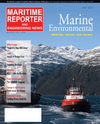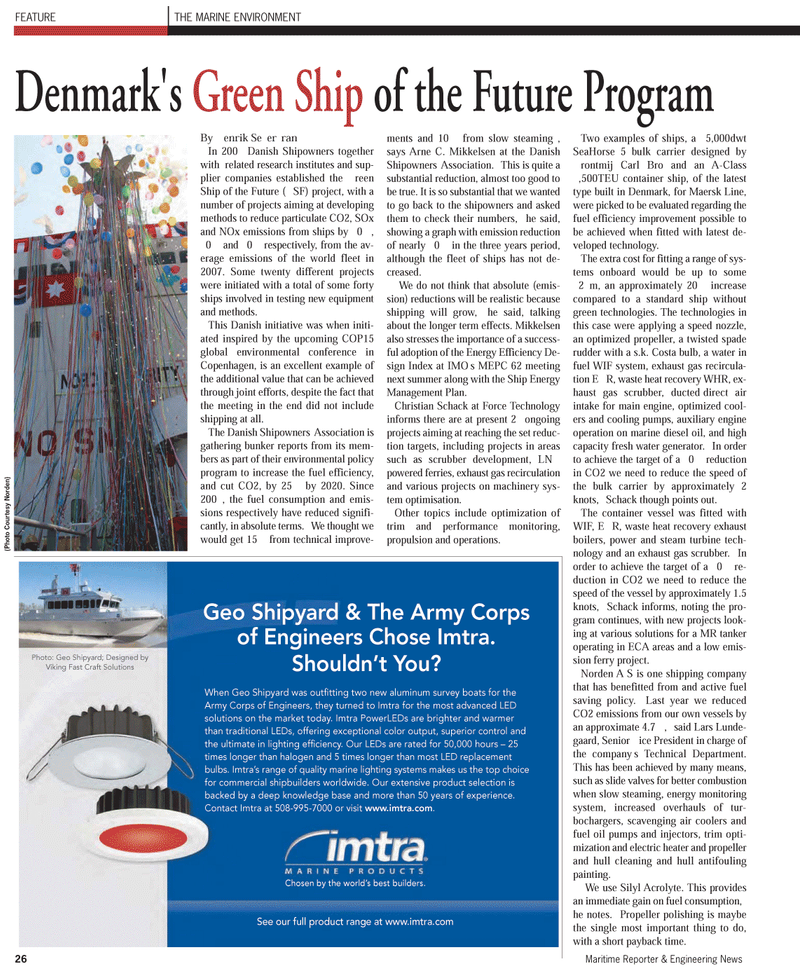
Page 26: of Maritime Reporter Magazine (July 2011)
The Green Ship Edition
Read this page in Pdf, Flash or Html5 edition of July 2011 Maritime Reporter Magazine
By enrik Seerran In 200 Danish Shipowners together with related research institutes and sup- plier companies established the reen Ship of the Future (SF) project, with a number of projects aiming at developing methods to reduce particulate CO2, SOxand NOx emissions from ships by 0, 0 and 0 respectively, from the av- erage emissions of the world fleet in 2007. Some twenty different projects were initiated with a total of some fortyships involved in testing new equipment and methods. This Danish initiative was when initi- ated inspired by the upcoming COP15global environmental conference in Copenhagen, is an excellent example of the additional value that can be achieved through joint efforts, despite the fact that the meeting in the end did not includeshipping at all.The Danish Shipowners Association is gathering bunker reports from its mem- bers as part of their environmental policy program to increase the fuel efficiency, and cut CO2, by 25 by 2020. Since 200, the fuel consumption and emis- sions respectively have reduced signifi- cantly, in absolute terms. We thought we would get 15 from technical improve- ments and 10 from slow steaming, says Arne C. Mikkelsen at the Danish Shipowners Association. This is quite a substantial reduction, almost too good tobe true. It is so substantial that we wanted to go back to the shipowners and asked them to check their numbers, he said, showing a graph with emission reduction of nearly 0 in the three years period, although the fleet of ships has not de-creased. We do not think that absolute (emis- sion) reductions will be realistic becauseshipping will grow, he said, talking about the longer term effects. Mikkelsen also stresses the importance of a success-ful adoption of the Energy Efficiency De- sign Index at IMOs MEPC 62 meeting next summer along with the Ship Energy Management Plan.Christian Schack at Force Technology informs there are at present 2 ongoing projects aiming at reaching the set reduc-tion targets, including projects in areas such as scrubber development, LN powered ferries, exhaust gas recirculation and various projects on machinery sys- tem optimisation. Other topics include optimization oftrim and performance monitoring,propulsion and operations. Two examples of ships, a 5,000dwt SeaHorse5 bulk carrier designed by rontmij Carl Bro and an A-Class ,500TEU container ship, of the latesttype built in Denmark, for Maersk Line, were picked to be evaluated regarding the fuel efficiency improvement possible to be achieved when fitted with latest de- veloped technology. The extra cost for fitting a range of sys- tems onboard would be up to some 2m, an approximately 20 increase compared to a standard ship withoutgreen technologies. The technologies in this case were applying a speed nozzle,an optimized propeller, a twisted spade rudder with a s.k. Costa bulb, a water in fuel WIF system, exhaust gas recircula- tion ER, waste heat recovery WHR, ex- haust gas scrubber, ducteddirect air intake for main engine, optimized cool- ers and cooling pumps, auxiliary engineoperation on marine diesel oil, and highcapacity fresh water generator. In order to achieve the target of a 0 reduction in CO2 we need to reduce the speed ofthe bulk carrier by approximately 2 knots, Schack though points out. The container vessel was fitted with WIF, ER, waste heat recovery exhaust boilers, power and steam turbine tech- nology and an exhaust gas scrubber. In order to achieve the target of a 0 re- duction in CO2 we need to reduce thespeed of the vessel by approximately 1.5 knots, Schack informs, noting the pro- gram continues, with new projects look- ing at various solutions for a MR tanker operating in ECA areas and a low emis- sion ferry project.Norden AS is one shipping company that has benefitted from and active fuel saving policy. Last year we reduced CO2 emissions from our own vessels by an approximate 4.7, said Lars Lunde- gaard, Senior ice President in charge of the companys Technical Department. This has been achieved by many means, such as slide valves for better combustion when slow steaming, energy monitoring system, increased overhauls of tur- bochargers, scavenging air coolers and fuel oil pumps and injectors, trim opti-mization and electric heater and propellerand hull cleaning and hull antifoulingpainting. We use Silyl Acrolyte. This provides an immediate gain on fuel consumption,he notes. Propeller polishing is maybe the single most important thing to do,with a short payback time.26Maritime Reporter & Engineering News When Geo Shipyard was out?tting two new aluminum survey boats for the Army Corps of Engineers, they turned to Imtra for the most advanced LED solutions on the market today. Imtra PowerLEDs are brighter and warmer than traditional LEDs, offering exceptional color output, superior control and the ultimate in lighting ef?ciency. Our LEDs are rated for 50,000 hours ? 25 times longer than halogen and 5 times longer than most LED replacement bulbs. Imtras range of quality marine lighting systems makes us the top choice for commercial shipbuilders worldwide. Our extensive product selection is backed by a deep knowledge base and more than 50 years of experience. Contact Imtra at 508-995-7000 or visit www.imtra.com . Chosen by the worlds best builders. Photo: Geo Shipyard; Designed by Viking Fast Craft Solutions See our full product range at www.imtra.com Geo Shipyard & The Army Corps of Engineers Chose Imtra.Shouldnt You? THE MARINE ENVIRONMENTFEATURE Denmark's Green Ship of the Future Program (Photo Courtesy Norden)

 25
25

 27
27
